
The whirligig beetles are water beetles, comprising the family Gyrinidae that usually swim on the surface of the water if undisturbed, though they swim underwater when threatened. They get their common name from their habit of swimming rapidly in circles when alarmed, and are also notable for their divided eyes which are believed to enable them to see both above and below water. The family includes some 700 extant species worldwide, in 15 genera, plus a few fossil species. Most species are very similar in general appearance, though they vary in size from perhaps 3 mm to 18 mm in length. They tend to be flattened and rounded in cross section, in plain view as seen from above, and in longitudinal section. In fact their shape is a good first approximation to an ellipsoid, with legs and other appendages fitting closely into a streamlined surface. Whirligig beetles belong to the beetle suborder Adephaga, which also includes ground beetles and diving beetles.
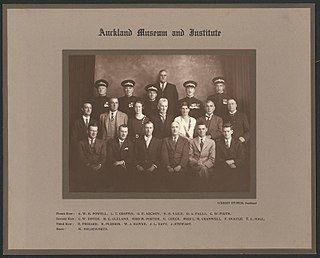
Arthur William Baden Powell was a New Zealand malacologist, naturalist and palaeontologist, a major influence in the study and classification of New Zealand molluscs through much of the 20th century. He was known to his friends and family by his third name, "Baden".
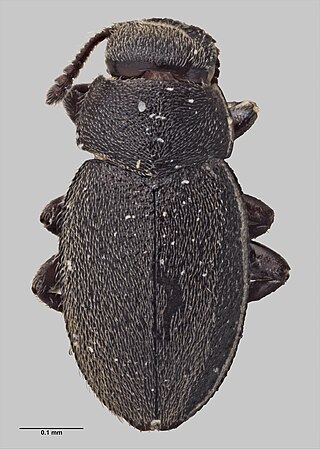
Hyphalus wisei is a species of intertidal beetle endemic to New Zealand.
Gyrinus gehringi is a species of whirligig beetle in the family Gyrinidae. It is found in North America.
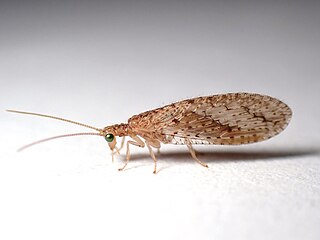
Micromus tasmaniae, known as the Tasmanian brown lacewing, is a species of brown lacewing in the family Hemerobiidae. It is widespread in Australia, New Zealand, and Pacific Islands such as New Caledonia and Vanuatu.

Chrysopa oculata is a species of green lacewing in the family Chrysopidae. It is found in North America and Central America. This species was imported to New Zealand in 1926, as a way to control aphid populations, however did not establish in the country.
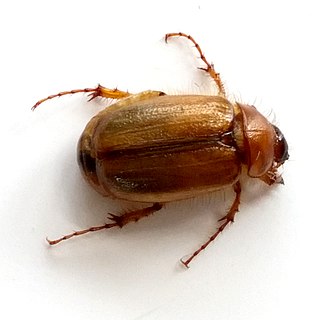
Costelytra zealandica is a species of scarab beetle found in forested areas of greater Wellington. It was originally described in 1846 by the British entomologist Adam White as Rhisotrogus zealandicus from a specimen obtained during the Ross expedition. The species is known to feed on roots of plants and trees, so is considered a pest for many farm pastures.

Mallada basalis is a species of green lacewing in the family Chrysopidae, first described by Francis Walker in 1853. No subspecies are listed in the Catalog of Life. The species was detected on mainland New Zealand in the 2010s.
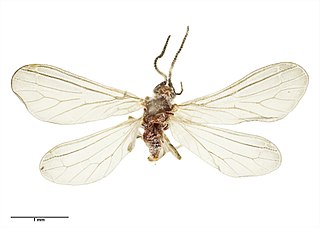
Cryptoscenea australiensis is a species of lacewing in the subfamily aleuropteryginae, first described by Günther Enderlein in 1906. No subspecies are listed in the Catalog of Life. The species is present in Eastern Australia, Tasmania and New Zealand, including the Kermadec Islands.

Drepanacra binocula, known as the Australian variable lacewing, is a species of brown lacewing in the family Hemerobiidae, found across Australia and New Zealand, including Lord Howe Island, Norfolk Island and the Kermadec Islands.

Protobiella zelandica is a species of New Zealand beaded lacewing in the family Berothidae that was first described by Robert John Tillyard in 1923. It is the sole known species in the genus Protobiella, and the only berothid endemic to New Zealand. No subspecies are noted in the Catalogue of Life.
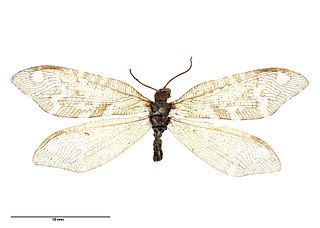
Euosmylus stellae is an endemic species of New Zealand lacewing that was first described by Robert McLachlan in 1899. It is the only species in the genus Euosmylus. The species ranges from the North Island Volcanic Plateau to the middle of the South Island, including Arthur's Pass and the Ashley Gorge. It was named in honour of George Hudson's daughter Stella.

Heteroconis ornata is a species of Australian lacewing that was first described by Günther Enderlein in 1905. The species is found in Queensland and New South Wales. The species was first recorded in New Zealand in 1988, and by the late 1980s a small colony was found to be established in West Auckland.

Microvelia macgregori is a species of true bug in the family Veliidae. It is semi-aquatic, living on the surface of water in freshwater habitats in New Zealand.

Mimopeus is a genus of darkling beetles in the family Tenebrionidae, first described by Francis Polkinghorne Pascoe in 1866. It is endemic to New Zealand.
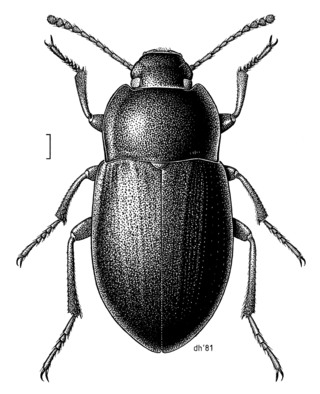
Mimopeus elongatus is a species of darkling beetle in the subfamily Tenebrioninae, first described by Ferdinando Arborio Gattinara di Breme in 1842, who considered it a type of Cilibe.

Mimopeus neglectus is a species of darkling beetle in the subfamily Tenebrioninae, first described by J. C. Watt in 1988. It occurs around the Cook Strait area of New Zealand, on both the North and South Islands.
Gyrinus sericeolimbatus, is a species of whirligig beetle found in India, Sri Lanka, New Guinea, Philippines, Solomon Islands.

Keith Arthur John Wise, often referred to as K. A. J. Wise, was a New Zealand entomologist. Originally employed at the Department of Scientific and Industrial Research, Wise began working with the Bishop Museum in the early 1960s, coordinating field programmes for United States visits to Antarctica and Subantarctic islands. This work led Wise to identify and describe large numbers of novel species, including many species of springtail. In 1965, Wise became the first Curator of Entomology at the Auckland War Memorial Museum, where he was integral in creating the first entomology section within the natural history gallery.
Alloecentrella is a genus of caddisflies belonging to the order Trichoptera. The genus was first recognised by Keith Arthur John Wise in 1958.

















